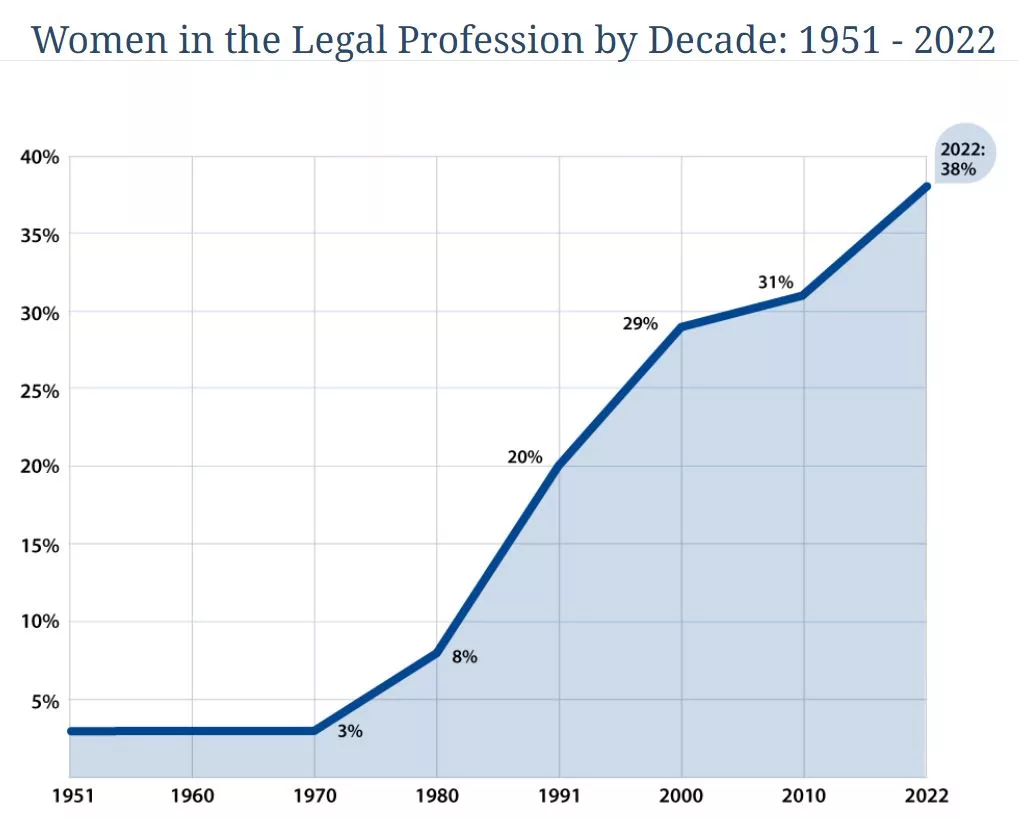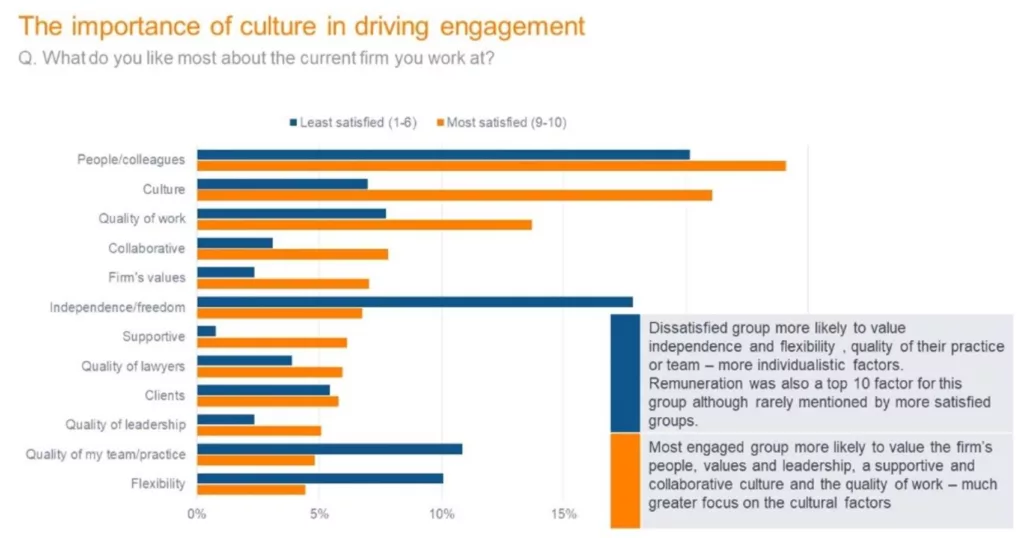Last year, we took an eye-opening look at the current treatment of women in law firms, how both attorneys and law firms can help reduce barriers of entry for women into the legal field, why a diverse workforce improves the overall health of a business, and some root causes for the lack of women attorneys at high levels. Results from newer surveys have been released, so it’s time to update with additional statistics and a glimpse into the future of women in law.
How many women attorneys are there in the US?
Last year, we shared that the first woman attorney in the US, Arabella Mansfield, was admitted to the Iowa bar in 1869 and there were at least 8,000 women attorneys by 1970. This means women have been practicing law in the US for over 150 years and have accounted for more than 40% of law students each year over the last several decades. Women have outnumbered men in law school in recent years, yet they continue to be underrepresented in the legal field as a whole in 2023, making up about 38% (or 494,000) of all attorneys.

Source: American Bar Association
From law school to partner – where do the numbers shift?
Our previous article focused on women within law firms because despite the fact more women graduate law school than men (and have done so for years), somewhere along the path from law school graduate to partner… the statistics shift drastically.
For years, the legal field suggested the reason for the difference in the percentage of women graduating law school vs. women at the partner level was because women were choosing to leave law to have a family instead of continuing on the path to partnership. This long-held belief fostered a culture within some law firms that young women attorneys were likely going to leave before becoming partner. And therefore, many young women in law firms haven’t received opportunities for advancement or mentorship compared to younger men attorneys.
However, thanks to a push to close the gender gap within law firms, research has come out that children are unlikely a factor for women leaving their firms. In a survey by Leopard Solutions, staying home with children was only a factor for 24% of women that left their law firms and was ranked sixth out of the seven factors that contributed to their departure. So, the gender gap isn’t due to childcare but something else…
When do women attorneys leave law?
With 49.5% of associates at US law firms being women yet only 23.9% of US law firm equity partners being women, the trend indicates a mid-career departure. This mid-career departure occurs at a significantly higher rate in women attorneys compared to men. The ratio of women that leave the practice of law compared to men leaving the practice of law in the middle of their careers is 73:27.
The gender gap that exists at the partner level of firms isn’t because women start their careers with the intention of leaving law before making partner. On the contrary, 75% of women attorneys say making partner is either very or somewhat important early in their careers, indicating their intention is to have a long-lasting legal career at the highest levels. So… if it’s not children or the lack of desire to make partner, why are women leaving law mid-career?
In the 2022 Leopard Solutions survey of women that left the practice of law, 85% of women cited a better or more supportive work culture could bring them back to the legal field. When we look at all these stats, they indicate a law firm culture that lacks equality, resulting in decades of trying to crack that glass ceiling is the main barrier for women pursuing a long-term legal career.
It seems the culture of many firms have not evolved regardless of the stage of an attorney’s career based on the personal comments shared with Leopard Solutions:
“My first job out of law school, I was aggressively sexually harassed, called “little girl”, and had constant comments about my appearance.”
“I was tired of having to fight with others (primarily men) for billing credit, for prime assignments, for marketing opportunities, and all things legal. I did it for over 30 years, and I was successful, but, wow, was it was exhausting.”
As women continue their legal careers, the gaps between salary, mentorship, and room for advancement grows with only 12% of managing partners at law firms being women. The gender gap doesn’t just apply to title and responsibility; the highest paid attorneys are women at only 2% of law firms.
Although these numbers may seem less than promising for women in law, this research has inspired true change within the legal community. Additional research has shown diverse businesses and law firms consistently outperform those that have little-to-no diversity, so improving the culture within law firms to encourage equality is a win-win situation that results in higher performance, more revenue, and happier attorneys.
The future of women in law
Now that we’ve discussed why and when women leave the practice of law, it’s time to look at the growth and encouraging outlook into the future of women attorneys. Today, 38% of all attorneys are women, and that percentage is growing by about .5% each year. Law firms around the US are taking a hard look at their recruiting and retention strategies to close that gender gap.
Last year, we shared 5 ways law firms can improve when it comes to creating a culture of diversity and innovation:
1. Encourage women attorneys to speak up about their experiences and concerns.
2. Make it clear that gender discrimination will not be tolerated.
3. Offer equal opportunities for promotion.
4. Provide training on unconscious bias and its impact on the workplace.
5. Encourage non-minorities to be allies in promoting gender equality (and all forms of equality) in the workplace.
You can read more details on these 5 practices in our original article, Women in Law and Law Firms’ Treatment of Women Attorneys. This year, we’re going into more detail about how improving a law firm’s culture can result in better recruitment, retention, revenue, and work environment as a whole.
The Role of the Recruiting Department
First, let’s dive into the importance of recruitment and why Diversity & Inclusion policies shouldn’t stop there. Recruiting is often the first point of contact law firms look to improve upon when realizing they need to cohesively grow the firm in a diverse and inclusive way.
A great starting point to recruiting a more diverse team of attorneys is to offer benefits that remove the barriers of entry for attorneys based on their background or location. Women attorneys that left law cited a more flexible work environment and the ability to work from home as two of the top 3 factors that would incentivize them to return to law.

Source: Leopard Solutions
Flexibility isn’t an uncommon request for attorneys in today’s digital environment. By implementing a virtual law firm option (or a fully virtual law firm model), recruiting shifts to focus on skill, personality, and experience more than the location of the firm and its attorneys. This opens the door to attorneys across the world from a variety of socioeconomic backgrounds.
Another way to recruit a diverse team is to have a diverse panel of recruiters. A diverse team of recruiters can help candidates envision themselves in the firm and growing within the firm compared to being recruited by a more homogeneous panel. IBM found that diversity with new hires increased from 31% to 45% simply by focusing on the diversity within their hiring team.
When we look back at the numbers, it makes sense that a woman attorney candidate would see that a law firm’s claim that they’re striving to improve gender equality falls flat if they’re only communicating with male attorneys (who make up 81% of top firm leaders) throughout the recruiting process. As a side note, we are proud to boast that 50% of our leadership team is women, including practice area chairs and heads of non-legal departments within the firm. From our own experience, we can say that the more diverse our team is, the more diverse candidates we meet during the recruitment process.
The biggest discrepancy in recruiting practices when it comes to women attorneys is the lateral hire. According to Leopard Solutions, “At many firms, more partners are hired laterally than were promoted from the ranks. Yet an abysmal 28.6 percent of the lateral partners hired at U.S. law firms were women.”
If only 28.6% of lateral partner hires are women, you can make sense of how US law firms go from 49.5% of associates being women to less than 24% of women holding an equity partner position. Encouraging diverse lateral partner hires would arguably make the largest difference when it comes to building a team of inclusion and equality. This area of lateral recruitment is where we personally have strived to improve over recent years. We’ve expanded our recruiting efforts by sponsoring diversity-focused bar associations, implementing data-backed approaches to our policies, and connecting with recruiting partners that encourage more inclusive hiring practices.
That being said, recruitment is only one part of the change that needs to occur to create a diverse and inclusive law firm culture. You can learn more about improving your recruiting practices here.
Retention & Revenue
Improving a law firm’s recruiting policies will get top talent in the door, but it won’t keep it unless firms start to take a hard look at the retention of their new hires. Looking at the numbers, law firms are losing money (and a lot of it) by not focusing at all on retention.
Most law firms spend a significant amount of time and money on recruiting and training new hires. This cost is hard to overcome when a fully trained, top talent attorney leaves before reaching their full potential. The more churn a law firm has, the more revenue they’re losing.
Failure to retain top talent is a lose-lose situation that negatively impacts the firm, its clients, and the attorney that left hoping to make partner or experience a better law firm culture. A recent study by Thomson Reuters found that the most satisfied attorneys at a firm marked the people at their firm and its culture as the two best parts of their job. Meanwhile, the least satisfied attorneys marked people, colleagues, and independence/freedom as the worst parts of their job environment.

Source: Thomson Reuters
This study shows that it really comes down to leadership and internal culture to improve retention. It’s up to leadership to challenge and improve the current culture. Asking attorneys for feedback on a regular basis to learn what works or doesn’t work is critical to the long-term success of a firm. Usually, law firms learn that culture is the main issue with retention once they start listening to their people.
Improving diversity and retention with culture
Culture has always been a core value within our law firm because it’s the reason most of us ended up at Practus in the first place (regardless of gender). Our values have embraced new thinking and ideas to deliver the best result to our clients while providing support that is responsive, innovative, simpler, and fair.
We’ve discussed Practus culture at length in other posts, but it’s because of our investment in our internal firm culture that we feel this passionate about improving the treatment of women and underrepresented attorneys within the legal field as a whole. The reality is, in order to truly give clients the full-service legal representation with independent, visionary lawyers that they deserve, a diverse team of attorneys and personnel is a must. When law firms have more attorneys that clients can relate to, they also bring in more revenue.
Representation matters because it allows attorneys to connect with clients and understand their issues. This ability to connect with each other stems from having attorneys from all backgrounds and areas of law. To encourage that representation, you’ll need to foster a culture of respect, innovation, opportunity, and open minds.
We recognize that we can improve when it comes to diversity and inclusivity. That’s why we’ve taken a hard look at our recruiting practices, retention, and outreach and are making changes to the way we grow our firm. Practus launched as a fully virtual law firm, which helps to recruit and retain attorneys from around the world, supporting a more diverse environment.
Infrastructure and recruitment are a great start for opening doors to talented yet underrepresented attorneys. Establishing a culture to support retention and developing a leadership team that encourages diversity, inclusion, and respect for everyone at the firm is where it comes full circle. It’s our belief that happier attorneys produce better work product. It’s hard to have a firm with happy attorneys when the internal culture is behind the times and rooted in implicit bias.
The good news? The legal field is improving and evolving each year. With more women attorneys practicing law than ever before, change is happening. Culture is evolving. It’s up to firms like ours to support this exciting evolution of law.
To learn more about Practus, please reach out to our VP of Recruitment, Stephanie Recupero, or head to our website.






